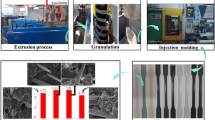Abstract
Polymer mixtures based on recycled polypropylene with the addition of an ethylene–octene copolymer underwent extrusion processing to improve its physical and mechanical properties. Experimental thermodynamic and structural parameters of the composite material and its physical and mechanical properties were obtained. An increase in relative elongation at break of the composite materials prepared with an extrusion method as strands and films is due to the plasticization of recycled polypropylene with an ethylene–octene copolymer and a decrease in degree of crystallinity in the range of compositions studied. The possibility of practical use of recycled polypropylene as a part of composite materials for light industry and long products (pipes and film packaging) is shown.



Similar content being viewed by others
REFERENCES
E. R. Audanova, “Polypropylene: From composition and structure to production technology,” in New Technologies. Proceedings of All-Russian Research and Practice Conference of Students, Graduate Students, and Young Scientists Devoted to the 50th Anniversary of Tyumen’ Industrial Institute-Tyumen’ Oil and Gas University (2013), pp. 89–91.
N. N. Komova, G. E. Zaikov, and S. N. Rusanova, “Influence of temperature regimes on deformation characteristics of microcompositions of polypropylene—low-density polyethylene,” Vestn. Kazan. Tekhnol. Univ. 15, 110–112 (2012).
K. Zdiri, A. Elamri, M. Hamdaoui, O. Harzallah, N. Khenoussi, and J. Brendlé, “Reinforcement of recycled PP polymers by nanoparticles incorporation,” Green Chem. Lett. Rev. 11, 296—311 (2018).
N. B. Krasnova, “Polypropylene as a basis of polymer composites, in New Challenges of Engineering and the Ways to their Solution. Proceedings of International Research and Practice Conference (2016), pp. 57–60.
K. V. Goryachkina, “Polypropylene as a modern polymer material,” Prioritetnye Napravleniya: Ot Teorii k Praktike, No. 33, 169–172 (2016)
A. R. Garifullina, R. R. Garipov, E. M. Repina, and V. A. Bamburkina, “Polypropylene: Its properties and application scope,” Alleya Nauki 2, 145–148 (2020).
L. V. Nikitina and E. A. Busygina, “Modified secondary polypropylene,” in Environmental Problems of Industrial Cities. Proceedings of the 6th All-Russian Research and Practice Conference with Foreign participants, Ed. by E. I. Tikhomirova (2013), pp. 65–67.
S. I. Volfson, N. A. Okhotina, A. I. Nigmatullina, R. K. Sabirov, O. A. Kuznetsova, and L. Z. Akhmerova, “Studies of rheological properties of dynamic thermoelasoplasts,” Vestn. Kazan. Tekhnol. Univ. 15, 58–59 (2012).
D. R. Paul and K. B. Bucknell, Polymer Mixtures, Vol. 2 Functional Properties, Ed. by V. N. Kuleznev, (Nauchnye Osnovy i Tekhnol., St. Petersburg, 2009).
J. Silva et al., “Morphology in multilayer blown films of polypropylene and ethylene-octene copolymer blends,” Int. Polym. Proc. 33, 345–352 (2018)
V. V. Myasoedova and A. V. Lushkova, “Ecosolution: Composites made of secondary propylene modified with thermoelastoplasts and disperse fillers,” Khim. Bezopasnost’ 2020, 265–281 (2020).
M. V. Bazunova, G. R. Ishyarova, G. M. Sharipova, and V. P. Zakharov, “Studies of the options for the use of secondary polypropylene as component of composite materials,” Dokl. Bashk. Univ. 3, 18–26 (2018).
L. G. Barbosa, C. R. Dalberto, and E. L. Francesquetti, “Obtaining an empirical equation for correcting the melt flow index of virgin and recycled polypropylene mixtures and analysis of mechanical properties of the blends,” Global J. Res. Eng. 20, 27–34 (2020).
Thermoplastic Elastomers, Ed. by D. Holden, H. R. Kricheldorf, and R. P. Quirk, 3rd ed. (Hanser Publishers, Munich, 2004; Professiya, St. Petersburg, 2011).
M. Okan, H. M. Aydin, and M. Barsbay, “Current approaches to waste polymer utilization and minimization: A review,” J. Chem. Technol. Biotechnol. 94, 8–21 (2019).
ACKNOWLEDGMENTS
The authors are grateful to the 506694 Center for Collective Research and UNU 1440743 at the Center of Chemical Physics of Russian Academy of Sciences for their fluorescence microscopy equipment.
Funding
This work was financially supported by program 35 of the Presidium of the Russian Academy of Sciences “Scientific Foundations to Create New Functional Materials” and government order “Development of Methods to Create Nanostructured Polymer, Biopolymer, and Composite Materials and Their Targeted Modification with Various Practical Applications,” no. AAAA-A20-120030590042-8 and 0082-2019-0008.
Author information
Authors and Affiliations
Corresponding author
Additional information
Translated by A. Tulyabaew
Rights and permissions
About this article
Cite this article
Myasoedova, V.V., Vasilyev, I.Y., Grachev, A.V. et al. Extrusion Processing of Polypropylene/Ethylene–Octene Copolymer Recycled Composite Material. Polym. Sci. Ser. D 15, 638–643 (2022). https://doi.org/10.1134/S1995421222040207
Received:
Revised:
Accepted:
Published:
Issue Date:
DOI: https://doi.org/10.1134/S1995421222040207




